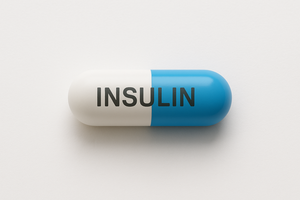
What is meant by “oral insulin,” and why does it matter?
“Oral insulin” usually refers to a capsule or tablet formulated to release insulin in the intestine rather than the stomach, so some of it can be absorbed into the portal vein that goes directly to the liver. This mimics the release of insulin from the pancreas directly to the liver, initially through the portal vein, allowing the liver to reduce glucose production and absorb much of the incoming glucose before it reaches the rest of the body. An oral insulin with liver-first (portal) delivery would improve fasting and post-meal glucose levels and minimize insulin exposure to other tissues.
Key terms
- Enteric coating: A protective capsule layer that resists stomach acid and dissolves in the small intestine.
- Bioavailability: The portion of a dose that actually enters your bloodstream to work.
- Portal vein/portal delivery: The vein that directly carries blood—rich in nutrients and naturally secreted insulin—from the gut and pancreas to the liver.
Why can’t I just swallow insulin today?
Insulin is a protein. Stomach acid and digestive enzymes break proteins into smaller pieces. Even if some insulin survives the stomach, it must then pass through a tightly sealed intestinal lining to reach the bloodstream. This results in very low and variable bioavailability. For an oral product to be effective in real life, it must:
- Protect insulin until it reaches the small intestine, and
- Help insulin cross the gut wall predictably, day after day.
Achieving both—safely—is the central challenge.
Is any oral insulin currently approved?
No—there is no FDA-approved oral insulin for routine diabetes care as of 2025. Current insulin options include injected forms (pens, syringes), infused options (insulin pumps/AID systems), or inhaled mealtime insulin for adults. If you see advertisements for an insulin pill, be skeptical and consult your healthcare provider.
What methods are scientists testing?
Researchers are employing multiple strategies to protect insulin and improve its absorption.
- Enteric, pH-responsive coatings that protect insulin in the stomach and release it in the intestine.
- Absorption enhancers that temporarily loosen tight junctions between intestinal cells or help insulin cross cell membranes.
- Nanoparticles, liposomes, and micelles that deliver insulin, sometimes aiming for liver-specific targeting.
Testing Overview
- Large trials have been challenging. For example, a late-stage (Phase 3) capsule program in type 2 diabetes failed to achieve primary goals in 2023—showing how difficult it is to deliver sufficient insulin reliably.
- Earlier pharmaceutical programs exploring oral insulin analogs were discontinued years ago due to low bioavailability and concerns about cost and feasibility.
- Active academic and industry research continues, with materials science and delivery chemistry advancing rapidly.
A brief historical note: the “Zot/zonulin” concept
Earlier research mentioned Zot (zonula occludens toxin), a protein derived from Vibrio cholerae that can open intestinal “tight junctions.” In the late 1990s, animal studies showed that temporarily loosening these junctions could increase insulin passage across the gut and lower glucose levels in diabetic rats. This work was foundational because it proved the concept that macromolecules might pass through the gut when barriers are modulated. However, translating that approach to safe, repeatable human dosing has been challenging, and zonulin-pathway strategies remain mainly in the research phase.
Who might benefit first if oral insulin is successful?
If an oral product eventually proves itself in large human trials, many experts expect its earliest application to be in type 2 diabetes, where a liver-first effect might better reduce the liver’s glucose output. It would likely complement GLP-1 medications that enhance insulin action and reduce insulin requirements.
Even without oral insulin, you have options today:
- Inhaled mealtime Fiasp insulin: A needle-free alternative for meal insulin. Not recommended for individuals with certain lung conditions or smokers. Discuss with your clinician.
- Modern pens and ultra-fine needles: Smaller gauges and shorter lengths improve comfort; use room-temperature insulin for injections when appropriate.
- Insulin pumps and AID systems: Automated insulin delivery (AID) pairs a pump with a CGM and an algorithm to adjust insulin in the background to improve glucose levels and ease the daily workload.
Pro tip: If fear of injections or device burden is a barrier, inform your healthcare team so they can address it. Small adjustments—such as needle choice, injection timing, or device selection—can significantly improve your experience.
Will oral insulin replace injections someday?
Maybe for some uses, but more likely it will just add to our toolbox. Any oral insulin must deliver a precise, repeatable effect despite daily changes in meals, gut motility, and illness. That’s a high standard. The promise is real; the proof must be, too.
The Bottom Line
- Oral insulin delivery could someday provide a more physiologic, liver-first effect and decrease injections—but it isn’t ready for clinical use yet.
- Today’s practical options include inhaled mealtime insulin, modern pens, pumps, and AID systems.
- Stay curious and cautious about new claims. Verify trial phases, outcomes, and approvals before making decisions.
Outbound links for more info:
- American Diabetes Association – Standards of Care: clinical guidance on insulin therapy and technology
- ClinicalTrials.gov: search oral insulin to see active and completed trials
- FDA – Afrezza (inhaled insulin) label: official prescribing information
- Mayo Clinic – Insulin therapy overview: patient-friendly education
- Journal of Clinical Investigation (historical Zot/zonulin research): foundational work on intestinal permeability
Reference Articles:
- Zhang, Ershuai, et al. “Recent advances in oral insulin delivery technologies.” Journal of Controlled Release 366 (2024): 221-230.
- Low, Chan Yew, et al. “Critical updates on oral insulin drug delivery systems for type 2 diabetes mellitus.” Journal of Nanobiotechnology 1 (2025): 16.
- Alfatama, Mulham, et al. “A comprehensive review of oral chitosan drug delivery systems: applications for oral insulin delivery.” Nanotechnology Reviews 13.1 (2024): 20230205.
Last Updated on September 24, 2025
